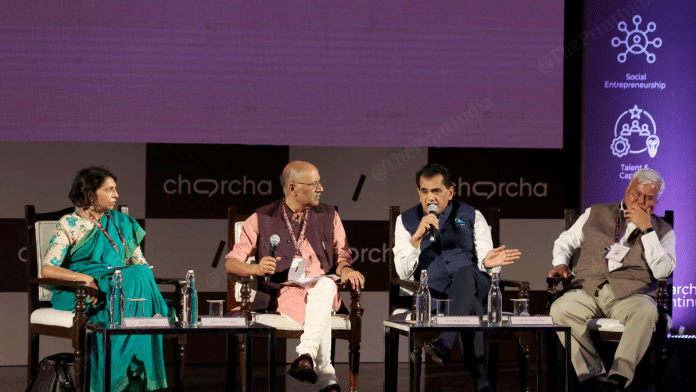New Delhi: It is essential to improve social indicators, transform learning and health outcomes, and make beneficiaries of various government schemes the “drivers of economy” for India to become ‘Viksit Bharat’ by 2047, the country’s G20 Sherpa Amitabh Kant said Tuesday.
Kant said that in the past decade several big ticket reforms, including digitization of the Indian economy, have been carried out. Now the challenge before the country is to grow to a $30 trillion economy. For this, he said, the per capita income has to increase. To achieve this, focus has to be on improving health outcomes and social indicators.
“We’ve grown at 8.2 percent (GDP). The challenge now is to really grow to a $30 trillion economy… But my belief is that it is not the size of the economy which is important. It’s the per capita income that is important. We are at about $2,500-plus, and we need to take that to $18,000-plus.
“The per capita income has to grow by eight times to reach $18,000-plus to be able to lift every single individual above the poverty line, and that would require a huge focus on about 50 percent of the population (which currently lives on welfare schemes and agriculture sector),” Kant said at a panel discussion, ‘Roadmap to a ‘Viksit & Inclusive’ India@100’.
The event was organised by Bengaluru-based non-profit organisation The/Nudge Institute as part of its fifth edition of livelihoods summit, ‘Charcha 2024’.
Arti Ahuja, former secretary of the Ministry of Labour and Employment, and Dr R.S.Sharma, CEO of the National Health Authority, were the other panellists at the discussion, which was moderated by Shekhar Gupta, founder-editor of ThePrint.
While India has witnessed a significant progress in digital infrastructure, road infrastructure and several structural reforms in the past decade, unemployment, income disparity, and skill gap among others continue to be pressing concerns before the government.
The panellists said that the development of digital infrastructure in India has helped in a big way in improving services. Aadhaar, Direct Benefit Transfer, UPI among others have transformed service delivery and its monitoring, they added.
“Technology is a great enabler for all kinds of reforms, measuring the outcomes, etc… I think even now there is a huge scope of improvement and leverage technology,” Dr Sharma said, while listing out various technological interventions in governance in the past decade.
The panellists asserted that the focus in the next two decades should be to build on the existing digital infrastructure and push the use of real-time data to improve social indicators and address the existing mismatch in skills and jobs.
“There is a mismatch between aspiration and capability…the agility of the job market means that people know what jobs are available, where they are available, and whether they are appropriate for those jobs… But recently, there was a survey that found nearly 50 percent of people who had applied (were not able to get the right jobs), and even companies are not able to fight the right kind of people. So there is this mismatch in the labour market, which I would say is the agility issue,” Ahuja observed.
She also stressed on need for inclusivity and to ensure the increased participation of women in the workforce. “Inclusivity has to become our mantra, not just for women but for other people. There are a lot of persons with disabilities who are not in the job market at all…The focus should also be on using real-time data to ensure correct matching of skills with jobs and also tapping into the aspirations of young people in the right manner.”
When asked about how India can encash its demographic dividend, Kant said, India needs to focus on its most populous states such as Uttar Pradesh, Bihar, Jharkhand, Chhattisgarh, Madhya Pradesh, and Rajasthan among others and improve the health and social indicators.
“You need to transform learning outcomes, health outcomes and nutrition standards in these states for India to grow on a sustained basis into a $30 trillion economy… It’s about focusing on outcomes and transforming capacity to deliver,” he said.
(Edited by Tony Rai)







By the time socialist India huffs and puffs to become a developed country, imagine where developed capitalist will be.